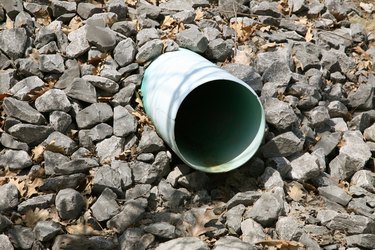Things You’ll Need
-
Marking paint
-
Shovel
-
Spade
-
Pick
-
Wheelbarrow
-
Tape measure
-
Pebbles or river rock
-
Landscape fabric
-
Sod
 A water pipe will direct the water away to a drainage site. Image Credit: Jupiterimages/Photos.com/Getty Images
A water pipe will direct the water away to a drainage site. Image Credit: Jupiterimages/Photos.com/Getty Images
It is hard to enjoy a soggy yard. Standing rainwater is not only a nuisance, but it can lead to odors and pose a health hazard. A storm drain is designed to channel the excess rain from your yard, paved streets, sidewalks and roofs to a more appropriate place. The French drain is the most common type of storm drain used for residential properties.
Planning Your Drain
Step 1
Check local building codes and secure any necessary permits before you begin. The codes for drainage systems vary from one municipality to the next. Be aware of where you can legally discharge storm water.
Step 2
Call your utility company to mark utility lines before you begin digging. If you fail to do so, you could break a pipe, which could lead to injury and a fine.
Step 3
Locate the area of your yard that floods during a storm. The trench should be located under the flooded area and lead to the point of discharge. Use the marking paint to mark your trench.
Digging the Drain
Step 1
Calculate the slope of the drain. Your line should slope at least a quarter inch per foot. You can calculate the slope by multiplying the length of the drain by the desired slope. For a 10-foot long drain, it would be 0.25 times 10.
Step 2
Excavate the trench. The trench can be between 6 and 12 inches wide and at least 36 inches deep. The wider a storm drain is, the easier it is to build and the more water that can pass through the drain.
Step 3
Shovel the soil into a wheelbarrow. Store it in a place so that it can be reused when it is time to cover the drain. If you have sod or turf, you will want to remove it and store it to be used again to finish the drain.
Finishing the Drain
Step 1
Cut two pieces of landscape fabric to run the full length of your trench, plus 2 feet. Lay them side-by-side so that they cover the trench and overlap onto the ground surface at both sides of the trench.
Step 2
Pour river rock or small pebbles over the landscape fabric until you are within 6 inches of the top of the trench. The rocks should have a diameter between between 1 and 2 inches for adequate drainage. Fold the excess landscape fabric over the rocks to cover the top of the trench. The fabric creates a water-permeable barrier that keeps soil from clogging the gravel and reducing the effectiveness of the trench.
Step 3
Fill the trench with the soil you reserved from digging. Lay sod over the soil to camouflage the drain. If the drain is located near a deck, sidewalk or patio, you can use decorative rock to fill the drain.
Tip
A French drain is designed to allow the water to slowly seep back into the soil. If you need the drain to move the water away from the home, consider installing a pipe in the bottom of your drain.
Warning
Always follow local building codes for this construction project.


